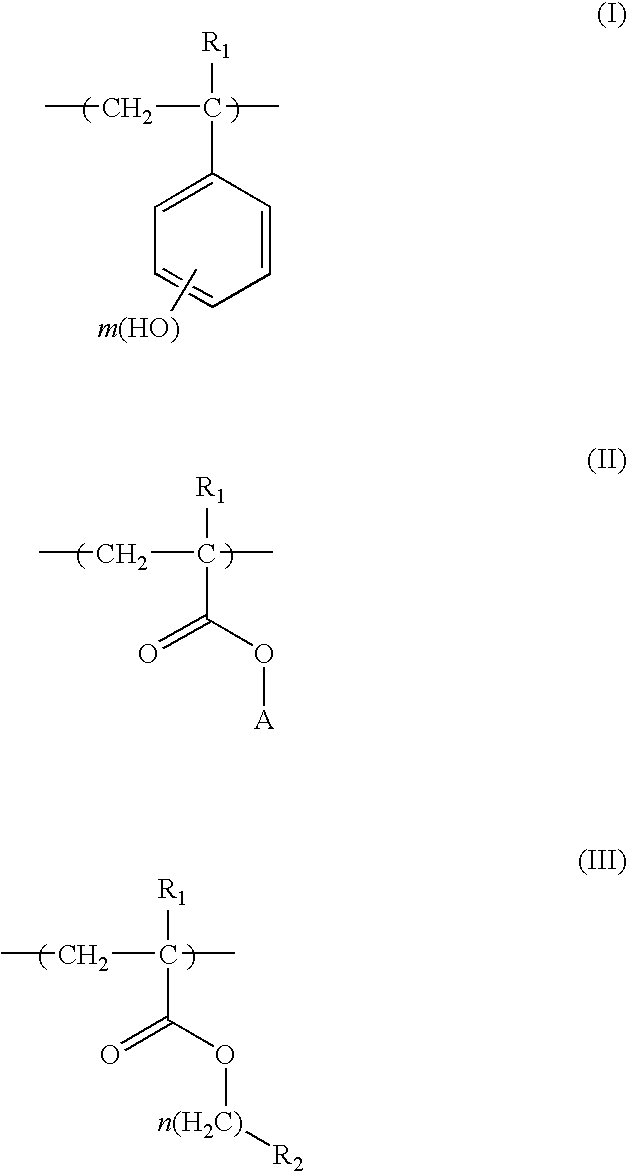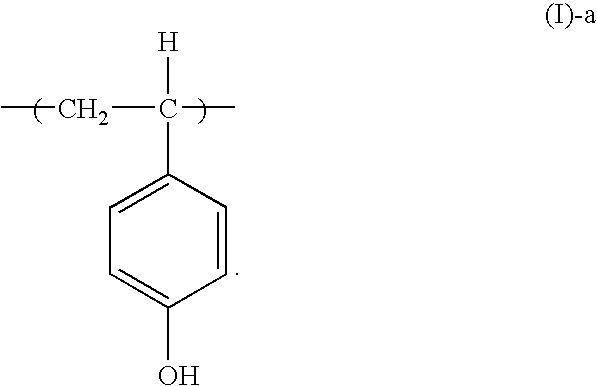Positive resist composition and pattern forming method using the same
a technology of composition and resist, applied in the field of positive resist, can solve the problems of excessively high dissolution rate of developer, and excessively low solubility of alkali developer, and achieve good pattern profile, sufficient depth of focus, and high resolution
- Summary
- Abstract
- Description
- Claims
- Application Information
AI Technical Summary
Benefits of technology
Problems solved by technology
Method used
Image
Examples
synthesis example 1
Synthesis of Polymer (A-6-1)
[0220]600 Gram of ethylene glycol monoethyl ether acetate was charged into a 2 L-volume flask, and nitrogen displacement was performed at a flow rate of 100 mL / min for 1 hour. Separately, 105.4 g (0.65 mol) of 4-acetoxystyrene, 35.6 g (0.25 mol) of tert-butyl methacrylate, 17.6 g (0.10 mol) of benzyl methacrylate and 2.30 g (0.01 mol) of polymerization initiator V-601 (produced by Wako Pure Chemical Industries, Ltd.) were dissolved in 200 g of ethylene glycol monoethyl ether acetate, and the obtained solution was subjected to nitrogen displacement in the same manner as above.
[0221]The temperature of the 2 L-volume flask containing ethylene glycol monoethyl ether acetate was raised until the inner temperature became 80° C., and 2.30 g (0.01 mol) of polymerization initiator V-601 was further added thereto. After stirring for 5 minutes, the monomer mixed solution prepared above was added dropwise with stirring over 6 hours. After the dropwise addition, the s...
synthesis example 2
Synthesis of Polymer (A-4)
[0223]600 Gram of ethylene glycol monoethyl ether acetate was charged into a 2 L-volume flask, and nitrogen displacement was performed at a flow rate of 100 mL / min for 1 hour. Separately, 105.4 g (0.65 mol) of 4-acetoxystyrene, 35.6 g (0.25 mol) of tert-butyl methacrylate, 16.0 g (0.10 mol) of phenyl methacrylate and 2.30 g (0.01 mol) of polymerization initiator V-601 (produced by Wako Pure Chemical Industries, Ltd.) were dissolved in 200 g of ethylene glycol monoethyl ether acetate, and the obtained solution was subjected to nitrogen displacement in the same manner as above.
[0224]The temperature of the 2 L-volume flask containing ethylene glycol monoethyl ether acetate was raised until the inner temperature became 80° C., and 2.30 g (0.01 mol) of polymerization initiator V-601 was further added thereto. After stirring for 5 minutes, the monomer mixed solution prepared above was added dropwise with stirring over 6 hours. After the dropwise addition, the sol...
PUM
| Property | Measurement | Unit |
|---|---|---|
| carbon number | aaaaa | aaaaa |
| polydispersity | aaaaa | aaaaa |
| carbon number | aaaaa | aaaaa |
Abstract
Description
Claims
Application Information
 Login to View More
Login to View More - R&D
- Intellectual Property
- Life Sciences
- Materials
- Tech Scout
- Unparalleled Data Quality
- Higher Quality Content
- 60% Fewer Hallucinations
Browse by: Latest US Patents, China's latest patents, Technical Efficacy Thesaurus, Application Domain, Technology Topic, Popular Technical Reports.
© 2025 PatSnap. All rights reserved.Legal|Privacy policy|Modern Slavery Act Transparency Statement|Sitemap|About US| Contact US: help@patsnap.com



